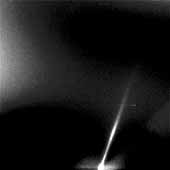|
COMETS EARTH JUPITER KUIPER BELT MARS MERCURY METEORITES NEPTUNE OORT CLOUD PLUTO SATURN SOLAR SYSTEM SPACE SUN URANUS VENUS ORDER PRINTS
PHOTO CATEGORIES SCIENCEVIEWS AMERICAN INDIAN AMPHIBIANS BIRDS BUGS FINE ART FOSSILS THE ISLANDS HISTORICAL PHOTOS MAMMALS OTHER PARKS PLANTS RELIGIOUS REPTILES SCIENCEVIEWS PRINTS
|
Related Documents
Download Options
Saturn's tenuous outer E-ring lies from about 180,000 kilometers to 640,000 kilometers from the planet. The ring's brightness peaks near the orbit of Saturn's moon Enceladus with vertical thickness smallest at this orbit. This indicates that Enceladus may be the source of the ring. Voyager spacecraft photographs show that Enceladus appears to be curiously smooth almost as if it has been recently resurfaced by watery volcanoes or geyser. Erupting geysers may be responsible for ejecting material into the E-ring. Another predominant theory suggests that the ring material may be ejecta that was blasted off of Enceladus' surface by bombarded with particles traveling at extremely high velocities. As these particles strike the surface they are destroyed in micro-explosions that ejects new particles into space. Over time these particles may be destroyed by self-collisions or by colliding once again with the parent satellite. One of the unusual characteristics of the E-ring is that it is predominately composed of micron sized grains with a distinct blue color. When particles are ejected into space they are subject to the gravitational forces that control the orbits of the moons and planets; however, small particles are greatly affected by other forces such as light pressure from the Sun, and electromagnetic fields around Saturn. Micron sized particles seem to be privileged. The gravitational and size-dependent non-gravitational forces balance for micron size particles. Only micron-sized particles can survive for long periods of time and spread out over the large expanse of the E-ring. Also visible in this image, between the E Ring and the overexposed outermost part of the main rings near the lower edge of the frame, is the tenuous, thin, 8000 km-wide G Ring. Noticeably thinner than the E Ring and more neutral in color, the G Ring is thought to be composed of larger, macroscopic particles. The faint diagonal band in the lower right part of the image is due to diffracted light from the heavily-overexposed planet. |
||||||||||||||||||||||||||||||||||||
